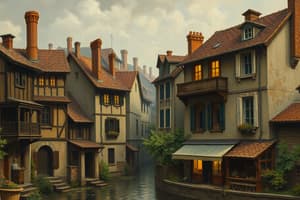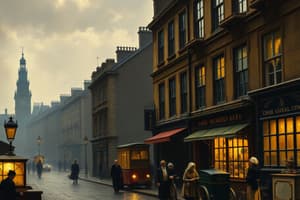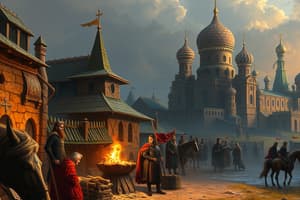Podcast
Questions and Answers
What was the desire that all Progressives had in common?
What was the desire that all Progressives had in common?
pass reform laws
What background did most Progressives come from?
What background did most Progressives come from?
the middle class
What did Progressive city reformers see as the first, most important step toward their goal?
What did Progressive city reformers see as the first, most important step toward their goal?
getting rid of the political machines that ran city politics
Who were muckrakers?
Who were muckrakers?
What did the Boy Scouts and Girl Scouts focus on unlike other groups?
What did the Boy Scouts and Girl Scouts focus on unlike other groups?
What hurt machine politicians?
What hurt machine politicians?
What did settlement houses do?
What did settlement houses do?
What did workers want more control of?
What did workers want more control of?
What major concerns did business owners have about labor unions?
What major concerns did business owners have about labor unions?
What is 'How the Other Half Lives'?
What is 'How the Other Half Lives'?
What were bonanza farms?
What were bonanza farms?
What is the National Grange?
What is the National Grange?
What was the Populist Party?
What was the Populist Party?
Who was William Jennings Bryan?
Who was William Jennings Bryan?
What were some advantages for farmers?
What were some advantages for farmers?
What were some challenges for farmers?
What were some challenges for farmers?
What does a lien on a farmer's land mean?
What does a lien on a farmer's land mean?
Why did farmers lose political power in the late 1800s?
Why did farmers lose political power in the late 1800s?
What was the farmers' biggest complaint against railroads?
What was the farmers' biggest complaint against railroads?
What was the main reason for farmers forming alliances?
What was the main reason for farmers forming alliances?
What is bimetallism?
What is bimetallism?
What was significant about the Munn v. Illinois case?
What was significant about the Munn v. Illinois case?
What did Eugene Debs advocate for?
What did Eugene Debs advocate for?
What do Progressives aim to address?
What do Progressives aim to address?
What role did settlement houses play?
What role did settlement houses play?
What was the biggest complaint of farmers about the railroads?
What was the biggest complaint of farmers about the railroads?
What does a recall allow voters to do?
What does a recall allow voters to do?
How did Progressives differ from Populists?
How did Progressives differ from Populists?
What was the aim of muckrakers?
What was the aim of muckrakers?
Study Notes
Living Conditions in Urban Areas
- "How the Other Half Lives" by Jacob Riis documented poor living conditions in New York City's slums during the 1880s.
- Riis' photographs highlighted the struggles faced by impoverished families in tenements.
Agriculture and Economic Trends
- Bonanza Farms emerged in the late 1800s, specializing in large-scale wheat production, fueled by advances in farm machinery, cheap land, and efficient railways.
- Farmers generally faced both positive impacts from railroads—such as faster crop shipping and increased land availability—and negative outcomes, including debt and reliance on cash crops.
Farmer Advocacy and Political Movements
- The National Grange, formed in 1867, aimed to improve the economic welfare and political influence of farming families.
- The Populist Party (People's Party) represented ordinary people’s interests, particularly farmers and factory laborers, from 1891 to 1908.
Key Political Figures
- William Jennings Bryan was a prominent politician, notably losing presidential elections in 1896 and 1900 but advocating for populist causes including bimetallism—encouraging currency backed by both gold and silver.
Economic Challenges for Farmers
- Farmers often struggled with debt due to the need to purchase tools and seeds, leading to a cycle of financial dependency on merchants.
- Increased farm production eventually resulted in overproduction, driving down crop prices as supply exceeded demand.
Social and Economic Dynamics
- Sharecroppers faced challenges as landowners claimed a significant portion of their produce before it could be planted.
- Merchants would extend credit, but higher prices and interest rates exacerbated farmers' debt burdens.
Regional Dependency on Railroads
- The Plains, Southwest, and West regions were particularly reliant on railroads for crop shipment due to their distance from major population centers.
Farmer Alliances and their Impact
- Farmers organized into cooperatives to standardize sale prices and bolster collective bargaining power against unfavorable economic conditions.
- The Grange movement notably fostered political change, achieving landmark victories like the Supreme Court case Munn v. Illinois which upheld Granger laws.
Populism and Progressive Movement
- Progressives sought to address urban social problems, emphasizing reforms to counteract issues like poverty and government corruption, contributing to a growing awareness of workers’ rights.
- While the Populist movement focused on agriculture, many idealistic Progressives emerged from the middle class and were predominantly urban dwellers.
Labor Movements and Unionization
- Eugene Debs, a key labor leader, advocated for workers' rights and helped establish the Industrial Workers of the World.
- The International Ladies' Garment Workers' Union (ILGWU), founded in 1900, significantly improved working conditions for women in the clothing industry.
Direct Political Involvement
- Initiatives such as referendums, recalls, and secret ballots aimed to empower citizens politically and reduce corruption in elections.
- The Seventeenth Amendment altered U.S. Senate selection, allowing for direct election by the people instead of state legislatures.
Settlement Houses and Social Reform
- Settlement houses served as community centers for educating impoverished urban residents and assisting them with social services and advocacy.
- Jane Addams, a pioneer in the settlement house movement, received the Nobel Peace Prize for her humanitarian efforts.
Muckraking Journalism
- Muckrakers like Lincoln Steffens aimed to expose societal issues, inspiring public demand for reforms through investigative reporting.
Class and Regional Conflicts
- Tensions existed between northern and southern farmers regarding protective tariffs, reflecting broader economic divides.
- Racial dynamics within alliances complicated efforts for solidarity among farmers of different regions and backgrounds.
Societal Changes and Youth Programs
- Organizations like the Boy Scouts and Girl Scouts emphasized physical fitness and self-sufficiency, teaching essential life skills to youth.
Working Conditions and Rights
- Workers sought greater control over their pay, work conditions, and hours, challenging the authority of business owners who feared loss of control due to rising labor unions.
Studying That Suits You
Use AI to generate personalized quizzes and flashcards to suit your learning preferences.
Description
Explore the living conditions in urban areas as documented by Jacob Riis in his work 'How the Other Half Lives'. Understand the emergence of Bonanza Farms and the political movements aimed at improving the lives of farmers, including the National Grange and the Populist Party.




